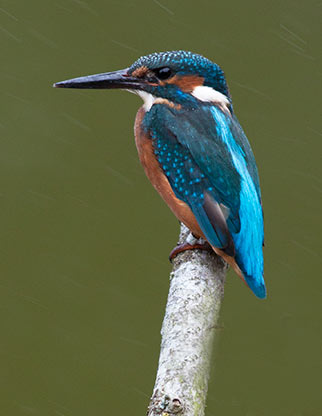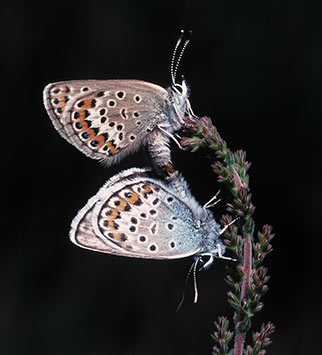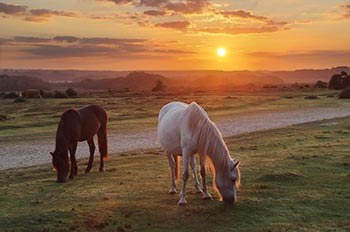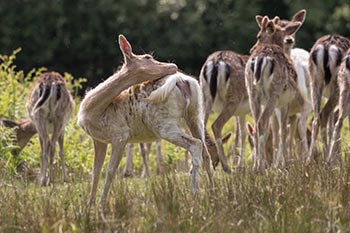New Forest wildlife - an introduction

The sheer abundance of New Forest wildlife makes the Crown lands a naturalist’s paradise.
A cliché? Maybe. But it's true.
New Forest wildlife can be found in staggering variety in what is a unique eco-system located in the midst of increasingly urbanised southern England. Of particular importance are the ancient, unenclosed woodlands, the valley mires and the heathlands, all habitats that are scarce elsewhere in Britain and throughout much of western Europe. And, of course, nearby is the wildlife-rich New Forest National Park coastline.
New Forest wildlife: where should one start when describing such riches?
Well, on the Crown Lands around 100 bird species are frequent breeders, whilst a further 20, or so, can be seen as regular winter visitors or passage migrants. The roll call is impressive, and includes birds such as the hen harrier, redshank, lapwing, curlew, snipe, kingfisher, nightjar, woodlark, Dartford warbler, firecrest, great grey shrike, common crossbill and hawfinch. And, of course, a great many more occur on the adjoining coastline.
Four species of deer are present in good numbers. Look out for the tiny roe deer; the magnificent red deer - Britain’s largest land mammal; for fallow deer, and sika deer, too. A fifth might also occasionally be seen: the inconspicuous muntjac that hides away in some of the denser woodland.
Foxes and Badgers are widespread, whilst Otters and Pine Martens are also present, and at least 9 bat species have been noted, including the extremely rare Bechstein’s and Barbastelle bats.
Fifteen species of orchids and a wide range of other wild flowers grow in the New Forest, some of which are incredibly rare elsewhere – flowers such as the endemic wild gladiolus, the bog orchid, slender cottongrass and pennyroyal.
Twenty-seven, or so, dragonfly species occur - that’s around 75% of all those found in Britain - including substantial populations of the scarce, southern damselfly. And almost forty butterfly species grace the area, including strong populations of pearl-bordered fritillaries that elsewhere have declined at an alarming rate, and silver-studded blues that in most other places are rare or absent.
Outstanding communities of other invertebrates are also present, many living in or on dead and decaying timber in the ancient, pasture woodlands - creatures such as the imposingly large stag beetle, hornets, dung beetles and southern wood ants.

silver-studded blue butterflies
All Britain’s native reptiles are present, encouraged by the New Forest’s relatively mild climate - adders, grass snakes, the rare smooth snake, slow worms, common lizards and the incredibly scarce, sand lizard. A range of amphibians also breed in permanent or temporary pools, including, of course, frogs and toads, but also smooth, palmate and great crested newts.
Over 2,600 species of fungi have been identified in the New Forest, and although many can only be told apart by experts, it’s an incredible tally, whilst the New Forest hosts what is often considered to be one of the richest moss, lichen and fern communities in the whole of western lowland Europe.
Not surprisingly, the Crown Lands of the New Forest have attracted a number of major wildlife / conservation designations. They are :
a) Site of Special Scientific Interest (SSSI)
b) National Nature Reserve
c) Wetland of International Importance under the Ramsar Convention 1993
d) Special Protected Area for Birds (SPA)
e) Candidate Special Area of Conservation
The Crown Lands of the New Forest also form by far the major component of the New Forest National Park.
And then there are also New Forest National Park and other nearby coastal sites to consider. Reflecting the amazing variety and abundance of wildlife to be found there, a large proportion of the coastal area is a Site of Special Scientific Interest (SSSI), and the Solent and Southampton Water have been designated a RAMSAR site especially important for waterfowl and are a Special Protection Area (SPA).
Other coastal conservation designations include the Keyhaven and Pennington grazing marshes, Sturt Pond and Calshot Marshes as Local Nature Reserves, and the Lower Test nature reserve as a Site of Nature Conservation Importance (SNCI). There are also two Special Areas of Conservation (SAC) - the Solent Maritime SAC and the Solent and Isle of Wight Lagoons SAC.
A naturalist’s paradise? Yes, most certainly.
Find out more about New Forest wildlife
References:
The New Forest – A Natural History: Colin R. Tubbs
Hampshire Bird Reports: Hampshire Ornithological Society
The Flora of Hampshire: Anne Brewis, Paul Bowman and Francis Rose
The Butterflies of Hampshire: Matthew Oates, John Taverner, David Green et al
The Dragonflies of Hampshire: John Taverner, Steve Cham, Alan Hold et al
Fungi of the New Forest – A Mycota: Edited by Gordon Dickson and Ann Leonard
More links
Search this site

Sadly, 58 animals were killed - 35 ponies, 13 cows, 8 donkeys and 2 sheep, whilst a further 32 were injured - 3 pigs, 9 donkeys, 11 cows and 9 ponies.
(Forty-three accidents occurred in daylight, 15 at twilight and 101 in the dark. Twenty-seven accidents were not reported by the driver involved).
Here's just one horrific example - Three donkeys killed in collision with van at notorious New Forest blackspot (Advertiser and Times)


Lesser celandine blooms illuminate woodlands, and heathland edges.
Fallow deer remain in single sex herds, the bucks at this time always separate from the does.
Curlews return from the coast to breed in and around the New Forest's wetter areas.
Red admiral butterflies are increasingly seen on bright, sunny days.
April
Redstarts are amongst the first returning long-distance migrant birds that arrive in April.
Large red damselflies take to the wing, the first of many such species that will soon be seen in the New Forest.
Bluebells blossom, sometimes in good numbers in ungrazed woodlands.
Badger cubs usually first appear above ground towards the end of the month.

